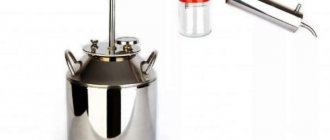To prepare moonshine at home, you will definitely need a device such as a distillation column.
When I first walked into a moonshine still store, I was seriously surprised by the assortment of all kinds of equipment presented.
It was the columns that caught my attention the most. If other additives had approximately the same appearance, then the columns could be radically different.
The difference in size could be up to 5-7 times. Then I began to wonder why this was so, and I was able to formulate the answer to my question only after I tried several different options.
What is a distillation column?
First, you need to understand what a distillation column is and how it differs from a distiller. Rectification is the separation of a mixture containing alcohol and containing many other components into fractions. The process is based on the difference in boiling point of various fractions, heavy and light. In addition to ethyl alcohol, ordinary mash contains methanol, aldehydes, fusel oils, water, etc. The rectifier allows you to separate all these substances.
This is interesting! Using a distillation column, various types of hydrocarbon fuels are obtained from oil: gasoline, kerosene, diesel and heavy fractions.
The column itself is a pipe located above the distillation cube. The device is made of copper or stainless steel; inside it consists of contact elements (plates or nozzles) on which various fractions condense.
Operating principle of a distillation column
This is not to say that distillation and rectification are completely different. At the initial stage of the distillation process, the principle of their operation is largely similar. The column functions as follows:
When the mash is heated, it releases steam that rushes upward. Steam consists of fractions having different boiling points. The lightest fractions, having a minimum boiling point of 66-70°C, contain methanol. This is why the “heads” are separated. Next comes ethanol - boils at 78°C. The heaviest ones are the “tails”, containing a large amount of fusel oils; these are also separated.
In the column, the first, heaviest fractions, having begun to evaporate, cool down before reaching the reflux condenser and fall down. The lighter parts of the mash rise higher, reaching the reflux condenser, where the phlegm (condensate) comes into contact with the plates or nozzles.
To avoid pressure drops and associated dangers (explosion), as well as to obtain pure rectified alcohol without impurities, the column at the top is equipped with a special tube.
The concentrations of various components in the liquid and gaseous fractions are different, but any physical system strives for equilibrium. Nature is designed in such a way that systems located in contact with different environments (liquid and gas), pressure and temperature tend to become mutually closer in their properties. For example, in winter the atmosphere is heated by the ocean, which cools, because water is more energy-intensive than air.
There are two fractions in the distillation cube and column - liquid and gas. In contact with the liquid, the steam is enriched with substances with a low boiling point, and the liquid with high-boiling substances.
At the same time, the pressure and temperature of the system are equalized.
Due to the multidirectional movement of liquid and gas, when equilibrium is established in the system, in the upper part of the rectifier it is possible to select pure fractions that have turned from liquid into vapor.
Pros and cons of using a distillation column in distillation equipment
It is immediately worth noting that conventional distillation equipment is more accessible - it is cheaper and easier to use. But its functionality is less wide. Among the advantages of the column:
- the ability to obtain pure alcohol – rectified;
- distillation mode to obtain highly purified moonshine;
- the absence in the final product of foreign harmful impurities and substances that impair the taste of drinks.
The device also has disadvantages - the columns have lower productivity; when receiving the rectification, it is necessary to pour diluted raw alcohol into the distillation cube. This involves primary distillation in a moonshine still.
Many experienced distillers believe that a column is only needed to produce alcohol from raw materials that do not have any special valuable taste properties - sugar mash, old jam, etc. Otherwise, it is better to use a conventional apparatus.
Sieve Distillation Column
You can also use a special sieve column. It, depending on the number of installed plates (disks), allows you to obtain both highly purified moonshine and drinks while preserving the original flavor and aromatic composition of the raw materials.
The device is installed on universal distillation apparatuses with provided connections for mounting various additional devices.
What is the difference between a moonshine still and a distillation column?
The following example will help you better understand the fundamental difference between a column and a distiller.
From a mash with a strength of 10%, with the first distillation you can get alcohol with a strength of 40%, with a second distillation - 60%, and after distilling again - a product with a strength of 70%. Typical indicators for distilling mash in a distiller:
- from 10% - 40%;
- from 40% - 60%;
- from 60% - 70%;
- from 70% - 75%, etc.
Theoretically, after 9-10 repeated distillations, 96% alcohol is obtained, but in practice everything is a little more complicated. Distillation of liquids with an alcohol content of more than 20-30% has an increased risk of explosion. In addition, such repeated distillation is very energy-consuming and unprofitable from a financial point of view.
Today, even a high-quality professional distiller with a steamer does not allow achieving the same levels of purity and strength that a rectifier is capable of.
It should also be said about the differences in the properties of the final product. A brief overview of comparative characteristics is presented in the table.
| Property | Distillation | Rectification |
| Smell and taste | natural smell and taste | pure alcohol without taste or smell |
| Fortress | depending on the number of distillations, the quality of the mash and the type of apparatus, alcohol with a strength of 40-65% is obtained | up to 96% |
| Degree of fractional separation | low. Fractions are mixed, technology does not allow them to be separated | high. All fractions with different boiling points can be distinguished |
| Possibility of removing harmful impurities | average or below average. To achieve acceptable product quality, at least two distillations are required | very high. If the technology is followed, all impurities are removed |
| Alcohol losses | big. At best, you can take 80% of normal quality alcohol from the total potential | very small. In theory, it is possible to take all the alcohol, in real conditions - losses of at least 1-3% |
Rectification, at its core, is the simultaneous distillation of an alcohol-containing liquid; separation occurs on nozzles or plates located at different heights. The higher the nozzles are located, the lighter fraction condenses on them.
Types of moonshine stills and distillation columns
There are several different types of distillation columns for moonshine stills:
- film column (strengthening the drawer). Designed to produce strong alcohol and partially purify fusel oils. The last function is carried out thanks to the presence of a steam chamber;
- mash. Thanks to the presence of a column of this type, purified moonshine with a natural taste and smell is obtained;
- rectification The only type of device that allows you to get 96% rectified alcohol at home;
- transformer. A universal device that allows you to work in different modes. From conventional distillation (potstill) to pure rectification.
Nozzles for columns and their varieties
Truly passionate distillers are eager to experiment with nozzles for filling distillation columns. They use both factory models and all kinds of homemade ones. Among the first, three options can be distinguished.
- Wire regular nozzles made of metal mesh. The material is copper or stainless steel. Due to the large area, the heavy fractions are retained, flowing back into the distillation cube, and the volatile vapors of pure alcohol rise higher - into the condensing device (tubular or spiral refrigerator) and are supplied to the outlet in the form of a liquid.
Regular wire packing for distillation or mash column
- Bulk spiral nozzles. They consist of many tiny spirals. The material is also metal - stainless steel or copper. The latter is used to eliminate sulfur compounds, which greatly spoil the organoleptic characteristics of the final product.
Bulk spiral packings for distillation column
- Special ceramic or glass balls. They also serve to increase the working area of the column and retain heavy fractions.
Distillation column “Dobrovar Ermak”
Homemade nozzles sometimes have no worse performance qualities. Hobbyists make them from wire, twisting it into a spiral and cutting it into small pieces; they use various materials, often combining them.
Some distillers with extensive experience believe that a do-it-yourself distillation column for a moonshine still is the best option. But in order to get a truly effective device, you need to have the necessary knowledge and skills and understand the principles of operation of the device. Therefore, for beginners there is only one way out - to purchase a column in a specialized store. But, if you wish, a diagram of a distillation column for a moonshine still can be found on any forum dedicated to moonshine.
Characteristics of both devices
For a more detailed understanding of the difference between the two types of devices, it is worth comparing their external features and some other characteristics.
Volume
The volume of the distillation cube of an industrial rectifier is 12-20 liters or more. The distillation cube of the distiller has the same volumes. But the height and dimensions of the two devices are very different: the length of the column can reach 1.5-1.8 m and even more, the traditional distiller is much more compact.
Material
The material from which modern industrial production devices are made, both distillers and rectifiers, is most often stainless steel or copper. Brass fixtures are less common.
What is better to choose
There is no clear answer to this question. Both devices have their own advantages and disadvantages. The distiller allows you to get real homemade moonshine with a natural taste and smell. Such a device is much cheaper, easier to work with and safer.
The column produces pure alcohol, which must be brought to the required conditions for consumption. They do this according to the following scheme: add a certain amount of “tails” to the main body of the output. They will give the drink “soul”, natural taste and smell.
The transforming apparatus makes it possible to obtain both distillate and rectified product.
The rectified alcohol itself is used only for the preparation of tinctures, balms and liqueurs.
Optional equipment
Among the additional equipment necessary to establish the production of high-quality moonshine, you need a thermometer and a heating system if the cube is not equipped with an electric heater.
The same gadgets include the Panchenkov nozzle and the pasteurization tsar. The latter is installed above the drawer, under the reflux condenser. When using it, there is no need for double distillation of the mash.
Note! For distillation in a rectifier, it is better to use raw alcohol. This is a distillate obtained after the first distillation in a conventional moonshine still. Although mash is also distilled, it must first be filtered.
Common Questions
Beginners in the business of making alcohol and homemade drinks from it often have various questions. Here are the answers to the most common ones.
Is it possible to get a rectification certificate for one distillation from mash?
No. Direct distillation through a mash column can lead to clogging of the flask and nozzle due to the rise of foam. It is necessary to distill the mash, obtaining raw alcohol, dilute it to 15-20 degrees and distill it using a distillation column at low temperature.
Is a column needed to produce highly purified moonshine?
A distillation column for a moonshine still is not necessary to obtain such a product, although it is easier to do with it. To obtain a high-quality product, you can use fractional double distillation on a conventional apparatus.
Is it possible to obtain alcohol with a strength of 96 degrees using a regular moonshine still?
The maximum strength obtained on distillation equipment is 70-80 degrees. To obtain rectification (96 degrees), a distillation column is required.
Does a regular copper nozzle in a column replace alambiks, caps and coils made of that metal?
Yes, sulfur compounds are removed using a copper mesh or spiral filling no less effectively, and the cost of the nozzles is much less than copper distillation equipment.
The conclusions from the information presented are simple - distillation columns are designed to produce high-quality alcohol from not very valuable raw materials. Distilling mash from fruits, grains, and berries will require a more subtle approach and conventional distillation equipment. On the other hand, a distillation column is more suitable for beginners. With its help, it is easier to obtain alcohol without harmful and dangerous impurities. As a compromise, you can use a professional moonshine still with a distillation column, other useful devices, as well as the possibility of modernization.











